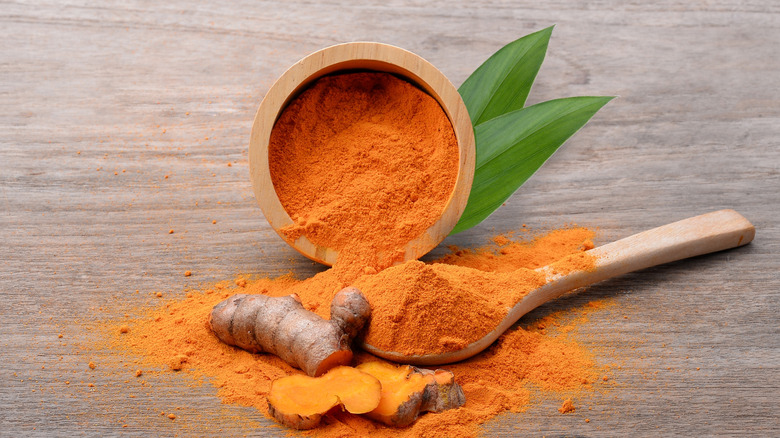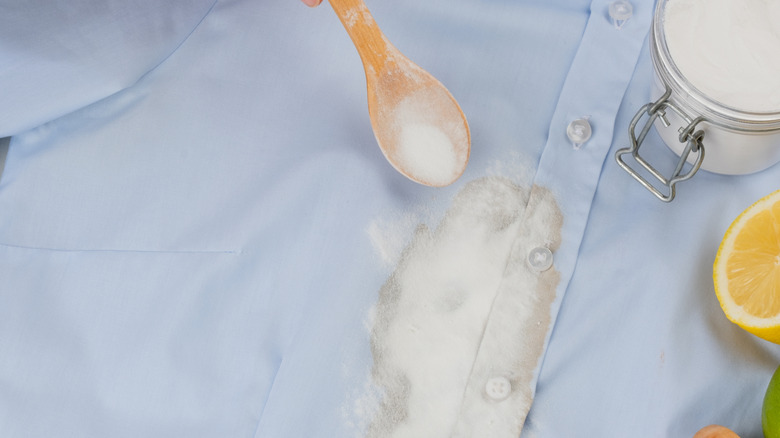How To Clean Turmeric Stains From All Your Clothes And Fabrics
Turmeric, a plant in the ginger family that's an important ingredient for classic Middle Eastern and Indian dishes, has a lot of uses. It's an antioxidant, has some surprising properties like acting as a pesticide when added to your garden, and contains curcumin, which gives turmeric its vibrant yellow color and can even address symptoms associated with some chronic illnesses. When it comes to staining, however, curcumin can bring some downsides. It's not water-soluble, which means it won't dissolve in water, and it binds to fabrics so strongly that turmeric is sometimes used to tie-dye clothes. So, when you're cooking and notice that distinct yellow pigment stain on your apron, clothes, or kitchen cloths, it might be easy to panic. But between commercial cleaners like dish soap and bleach and DIY solutions that you can substitute for stain remover, your stain doesn't have to be forever.
Depending on the color and kind of fabric you've stained, you might need to take a different approach to cleaning. For example, delicate fabrics can require the use of specific, delicate-friendly detergents, and you might be able to use bleach on white clothes, whereas bleach can cause discoloration on darker colored items. But across the board, acting quickly is key since turmeric absorbs fast, and it's also crucial to use cold water instead of hot so the stain won't set. Another tip is to apply a pre-treatment before adding water, and to blot instead of rubbing.
Pre-treatments and solutions for turmeric stains
Pre-treating a stain means addressing it before you jump straight to washing it, and because turmeric isn't water-soluble, simply wetting the stain won't be enough. To effectively pre-treat, first blot the stain and dust away any excess turmeric that's lingering on top of the garment, then apply a paste, cleaner, or mixture, mix it with cold water, and allow it to sit on the stain. Some options you can apply are a mild liquid detergent, baking soda, dish soap, white vinegar, or lemon juice. Some say you should let it sit for up to 15 minutes, but other experts suggest it might take at least an hour, so be sure to monitor the stain so you don't risk discoloration if the garment is left to sit for too long. But timing is dependent on your specific situation. For stains that are more set-in (say, you spilled turmeric on your clothes while out of the house and weren't able to address it until you got home), you might want to consider leaving the garment to sit in its pre-treatment overnight.
After you've let the solution sit on the stain for the appropriate amount of time, it's time to rinse and scrub — but to do both gently. It isn't just what you treat the garment with, but how you treat it, and you'll want to be careful that as you blot the stain, you aren't rubbing it in. Also, don't be afraid of a little repetition. Sometimes, it might take a few rounds of rinsing and scrubbing to get the job done. Then you'll be ready to run the garment through its normal laundry cycle.
When to see a professional cleaner
When your stain hasn't gone away with treatments or you're nervous that at-home remedies might cause further damage to your item, you might be wondering how to tell if you really need to dry-clean your laundry. When you're working with fabrics such as silk or velvet or clothing items with embroidery or embellishments, or if you haven't been able to get the stain out on your own, the answer might be yes. That's because dry cleaners have expertise and professional techniques, and they also have a trained eye to know what not to do with certain materials. For example, using a basic soap can turn a turmeric stain bright red — and if you don't have the eye for details such as pH levels, you might end up making a once-removable stain permanent.
Another factor to consider is that DIY solutions, like baking soda, can be an effective stain removing scrub on fabrics such as linens, but it can be damaging and too abrasive for less durable garments, such as silk clothing. The same is true of sunlight. Where some sources recommend leaving turmeric-stained clothes to dry in the sun after they've been treated, that practice can damage silk. Additionally, while many at-home solutions suggest tossing your garment in the washing machine after you've treated it, this won't always be possible for delicate garments. So, always check the care instructions — and when you're wary of the risks, it's better to be safe than sorry.


